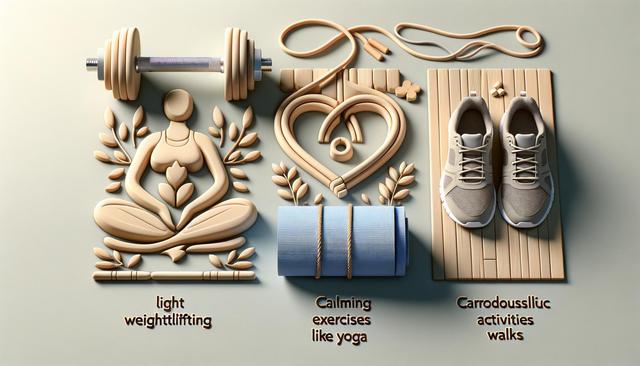3 Exercise Methods to Relieve Post – Stroke Symptoms
A stroke can bring about various physical impairments, but the right exercise methods can play a crucial role in recovery. By adhering to these three exercise approaches, stroke survivors can take positive steps towards relieving symptoms and regaining better physical function.1. Range – of – Motion Exercises

Range-of-Motion Exercises for Flexibility
After a stroke, stiffness and limited mobility in joints are common challenges. Range-of-motion exercises are designed to help restore flexibility and prevent muscle contracture. These exercises involve gently moving the affected limbs through their full motion to keep the joints flexible and maintain circulation. Especially during early stage stroke rehabilitation exercises, consistency with this method can significantly improve recovery outcomes. For example, gently lifting an arm overhead or rotating the wrist can help maintain mobility in the upper body. Practicing stroke recovery exercises for arm weakness with slow, controlled movements can also help prevent further muscle deterioration. These exercises are ideal for stroke rehabilitation exercises at home, as they require little to no equipment and can be adapted to each person’s capabilities.
Here are some simple range-of-motion movements to consider:
- Shoulder circles: Slowly move your shoulders in a circular motion to keep them mobile.
- Wrist bends: Flex and extend the wrist to maintain joint health and prevent stiffness.
- Leg lifts: While seated or lying down, lift one leg at a time to help improve hip mobility.
These movements should be done with support or supervision when needed, and always within a pain-free range to avoid injury.
Balance and Core Stability Exercises
Regaining balance after a stroke is crucial for reducing the risk of falls and improving independence. Balance exercises after stroke focus on strengthening the core and improving coordination between the brain and body. These activities help retrain the nervous system and stabilize posture. Incorporating balance exercises can support greater confidence in daily movements such as standing, walking, or transitioning from a chair.
Some practical balance exercises include:
- Heel-to-toe walk: Walking in a straight line by placing one foot directly in front of the other helps build coordination.
- Seated weight shifts: While sitting, shift weight from side to side to engage the core muscles and improve trunk control.
- Single-leg stands: Standing on one leg with support helps improve strength and balance in the lower body.
These are often included in programs featuring 3 simple exercises for stroke symptom relief and can be modified depending on the stage of recovery and individual ability.
Strength Training for Muscle Rebuilding
Muscle weakness is a common result of stroke, especially in the limbs. Strength training is essential to rebuild muscle mass and improve functional movement. Stroke recovery exercises for arm weakness often incorporate light resistance training to gradually strengthen the muscles without causing strain. These exercises should be performed under guidance initially, either with a therapist or through a structured program at home.
Effective strength exercises include:
- Resistance band pulls: Useful for rebuilding arm strength and coordination.
- Leg presses using body weight: Helps restore lower body strength and supports walking ability.
- Grip exercises using soft balls or therapy putty: Improves hand strength and dexterity.
These routines not only help with physical recovery but also contribute to greater independence in performing daily tasks like dressing, eating, and grooming.
Breathing and Relaxation Techniques
While physical movement is essential, breathing and relaxation techniques play a supportive role in stroke rehabilitation. These exercises help manage stress, reduce muscle tension, and improve overall endurance. Controlled breathing can also assist in reestablishing a connection between the brain and the body, making it a valuable part of early stage stroke rehabilitation exercises.
Incorporating breathing exercises into a daily routine may include:
- Deep diaphragmatic breathing: Encourages full lung expansion and promotes calmness.
- Progressive muscle relaxation: Focuses on tensing and releasing different muscle groups to foster awareness and relaxation.
- Seated meditation with guided breathing: Enhances focus and reduces anxiety associated with physical limitations.
These techniques are especially beneficial when incorporated alongside stroke rehabilitation exercises at home, offering both physical and emotional relief.
Consistency and Safety in Home-Based Recovery
Maintaining a consistent routine is key to seeing improvements. Stroke rehabilitation exercises at home provide flexibility and convenience, which are important for long-term commitment. However, safety should always be a top priority. Before beginning any exercise routine, it’s advisable to consult a healthcare provider or physical therapist to ensure the chosen methods are appropriate for the individual’s stage of recovery.
To stay safe and motivated at home, consider the following tips:
- Use supportive furniture or grab bars to maintain balance during exercises.
- Track progress with a journal to stay motivated and informed.
- Practice exercises at the same time each day to build a sustainable habit.
By focusing on 3 simple exercises for stroke symptom relief and adapting them to individual capabilities, stroke survivors can make meaningful progress. Whether focusing on stroke recovery exercises for arm weakness or balance exercises after stroke, the goal is to foster a gradual return to independence through safe and structured movement.
Conclusion: Moving Forward with Purpose
Recovering from a stroke is a journey that requires patience, support, and the right strategies. Incorporating a variety of targeted movements—such as range-of-motion activities, balance-focused drills, and strength-building routines—can significantly help relieve post-stroke symptoms. By choosing stroke rehabilitation exercises at home and staying consistent with practice, individuals can enhance their quality of life and regain greater control over their physical abilities. These exercise methods are not only foundational for early stage stroke rehabilitation exercises but also serve as a long-term framework for recovery and well-being.